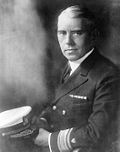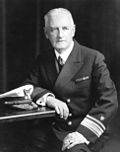| Name | Class | Notability |
|---|
| Worth G. Ross | 1879 | Captain-Commandant; 3rd Commandant of the Coast Guard (1905–1911), member of the first graduating class of the School of Instruction [21] |
| William E. Reynolds | 1880 | Rear Admiral; 5th Commandant of the Coast Guard (1919–1924) |
| Ellsworth P. Bertholf | 1887 | Commodore; last Captain-Commandant of the United States Revenue Cutter Service (1911–1915); 4th Commandant of the Coast Guard (1915–1919); [22] awarded Congressional Gold Medal for participation in the Overland Relief Expedition |
| Leonidas I. Robinson | 1889 | First Academy graduate to die in the line of duty |
| Frederick C. Billard | 1896 | Rear Admiral; 6th Commandant of the Coast Guard (1924–1932); Superintendent of the United States Coast Guard Academy (1921–1924) |
| Harry G. Hamlet | 1896 | Vice Admiral; 7th Commandant of the Coast Guard (1932–1936); Superintendent of the United States Coast Guard Academy (1928–1932); Gold Lifesaving Medal recipient; author of the "Creed of the United States Coast Guardsman" |
| Russell R. Waesche | 1906 | Admiral; 8th Commandant of the Coast Guard (1936–1946); longest serving Commandant |
| Philip F. Roach | 1907 | Commodore; recipient of the Navy Cross [23] |
| William J. Keester | 1910 | Rear Admiral; Commander of the 5th Coast Guard District |
| Joseph Stika | 1911 | Vice Admiral; recipient of the Navy Cross [24] |
| Joseph F. Farley | 1912 | Admiral; 9th Commandant of the Coast Guard (1946–1950) |
| Elmer Fowler Stone | 1913 | United States Naval Aviator, piloted the NC-4 on the first naval transatlantic flight [25] |
| Lyndon Spencer | 1918 | Vice Admiral; commanding officer of the USS Bayfield (APA-33) during World War II [26] |
| Harold G. Bradbury | 1920 | Rear Admiral; commanding officer of the USS Leonard Wood (APA-12), USS Wakefield (AP-21) and USCGC Duane (WPG-33) during World War II; Commander of the 1st Coast Guard District [27] |
| Merlin O'Neill | 1921 | Vice Admiral; 10th Commandant of the Coast Guard (1950–1954); 4th Vice Commandant of the Coast Guard (1946–1949) |
| Alfred C. Richmond | 1924 | Admiral; 11th Commandant of the Coast Guard (1954–1962) |
| Miles Imlay | 1926 | Rear Admiral; participated in the Normandy landings during World War II |
| Edward Thiele | 1927 | Rear Admiral; Engineer-in-Chief of the Coast Guard (1958–1961) [28] |
| Carl B. Olsen | 1928 | Rear Admiral; Commander of the 8th Coast Guard District [29] |
| Edwin J. Roland | 1929 | Admiral; 12th Commandant of the Coast Guard (1962–1966); 7th Vice Commandant of the Coast Guard (1962) |
| Allen Winbeck | 1929 | Rear Admiral; Commander of the 13th and 12th Coast Guard Districts [30] |
| A. J. Carpenter | 1933 | Rear Admiral; Commander of the 11th and 3rd Coast Guard Districts [31] |
| John Birdsell Oren | 1933 | Rear Admiral; Chief of Engineering |
| Willard J. Smith | 1933 | Admiral; 13th Commandant of the Coast Guard (1966–1970) |
| Chester R. Bender | 1936 | Admiral; 14th Commandant of the Coast Guard (1970–1974) |
| Chester I. Steele | 1937 | Rear Admiral; Commander of USCG Activities Europe (1964–1966) and the 2nd Coast Guard District (1966–1967) |
| Arthur B. Engel | 1938 | Rear Admiral; Superintendent of the Coast Guard Academy (1967–1970) [32] |
| Benjamin F. Engel | 1938 | Vice Admiral; Commander of the 14th and 3rd Coast Guard Districts [33] |
| Thomas R. Sargent III | 1938 | Vice Admiral; 11th Vice Commandant of the Coast Guard (1970–1974) [34] |
| Orvan R. Smeder | 1939 | Rear Admiral; Chief of Research and Development; Commander of the 7th Coast Guard District [35] |
| Ellis L. Perry | 1941 | Vice Admiral; 12th Vice Commandant of the Coast Guard (1974–1978) [36] |
| Owen W. Siler | 1943 | Admiral; 15th Commandant of the Coast Guard (1974–1978) |
| Winford W. Barrow | 1945 | Rear Admiral; Commander of the 8th Coast Guard District (1974–1978) |
| G. William Miller | 1945 | Chairman of the Federal Reserve (1978–1979); United States Secretary of the Treasury (1979–1981) [37] |
| John B. Hayes | 1947 | Admiral; 16th Commandant of the Coast Guard (1978–1982) [38] |
| Robert A. Duin | 1948 | Rear Admiral; Commander of the 17th Coast Guard District [39] |
| James S. Gracey | 1949 | Admiral; 17th Commandant of the Coast Guard (1982–1986) |
| Sidney A. Wallace | 1949 | Rear Admiral; Chief of Public and International Affairs (1975–1977) [40] |
| Benedict L. Stabile | 1950 | Vice Admiral; 14th Vice Commandant of the Coast Guard |
| Paul A. Yost Jr. | 1951 | Admiral; 18th Commandant of the Coast Guard (1986–1990) |
| Robert S. Lucas | 1952 | Rear Admiral; Commander of the 17th Coast Guard District [41] |
| James C. Irwin | 1953 | Vice Admiral; 15th Vice Commandant of the Coast Guard |
| Theodore J. Wojnar | 1953 | Rear Admiral; Commander of the 13th Coast Guard District [42] |
| William P. Kozlovsky | 1954 | Rear Admiral; Commander of the 14th Coast Guard District [43] |
| Clyde T. Lusk | 1954 | Vice Admiral; 16th Vice Commandant of the Coast Guard |
| J. William Kime | 1957 | Admiral; 19th Commandant of the Coast Guard (1990–1994) |
| Robert T. Nelson | 1958 | Vice Admiral; 18th Vice Commandant of the Coast Guard |
| William J. Ecker | 1960 | Rear Admiral; Commander of the 2nd and 5th Coast Guard Districts [44] |
| Richard A. Appelbaum | 1961 | Rear Admiral; Chief of Law Enforcement and Defense Operations [45] |
| Robert E. Kramek | 1961 | Admiral; 20th Commandant of the Coast Guard (1994–1998) |
| Arthur E. Henn | 1962 | Vice Admiral; 19th Vice Commandant of the Coast Guard |
| James C. Card | 1964 | Vice Admiral; 21st Vice Commandant of the Coast Guard |
| Richard D. Herr | 1964 | Vice Admiral; 20th Vice Commandant of the Coast Guard |
| James Loy | 1964 | Admiral; 21st Commandant of the Coast Guard (1998–2002); Acting Secretary United States Department of Homeland Security (2005), United States Deputy Secretary of Homeland Security (2003–2005); 2nd Administrator of the Transportation Security Administration (2002–2003); [46] |
| Gordon G. Piche | 1964 | Rear Admiral; Director of Personnel Management of the Coast Guard; Commander of Maintenance and Logistics Command Pacific [47] |
| Paul M. Blayney | 1965 | Rear Admiral; Commander of the Thirteenth Coast Guard District [48] |
| Thomas H. Collins | 1968 | Admiral; 22nd Commandant of the Coast Guard (2002–2006); guided the Coast Guard after the terrorist attacks of 9/11; 22nd Vice Commandant of the Coast Guard (2000–2002) |
| John T. Tozzi | 1968 | Rear Admiral; Director of Information and Technology (1996–1997) [49] |
| Richard W. Schneider | 1968 | Rear Admiral; former senior reserve officer in the United States Coast Guard Reserve and 23rd President of Norwich University for 28 years. |
| Terry M. Cross | 1970 | Vice Admiral; 24th Vice Commandant of the Coast Guard |
| Thad Allen | 1971 | Admiral; Principal Federal Official for the response to Hurricane Katrina, Hurricane Rita and National Incident Commander for the response to the Deepwater Horizon oil spill in the Gulf Coast region; 23rd Commandant of the Coast Guard (2006–2010) [50] |
| Ronald F. Silva | 1971 | Rear Admiral; Commander of the 9th Coast Guard District (2002–2004) [51] |
| Charles D. Wurster | 1971 | Vice Admiral; national commodore of the Sea Scouting division of the Boy Scouts of America [52] |
| Erroll M. Brown | 1972 | Rear Admiral; First African-American Coast Guard flag officer [53] |
| Bruce E. Melnick | 1972 | Commander; First Coast Guard astronaut [54] |
| Timothy S. Sullivan | 1975 | Rear Admiral; Senior Military Advisor and Operational Advisor to the United States Secretary of Homeland Security; Primary Military Coordinator between the United States Department of Homeland Security and United States Department of Defense [55] |
| Robert J. Papp Jr. | 1975 | Admiral; 24th Commandant of the Coast Guard (2010–2014) [56] |
| Paul A. Langlois | 1976 | Captain; Distinguished Flying Cross; USCGA Athletic Hall of Fame (2006); USCGA Hall of Heroes (2013); USCGA Distinguished Alumnus (2019) [57] [58] [59] |
| David Pekoske | 1977 | 7th Administrator of Transportation Security Administration (2017–Current); Vice Admiral; 26th Vice Commandant of the Coast Guard |
| Paul F. Zukunft | 1977 | Admiral; 25th Commandant of the Coast Guard (2014–2018) |
| Charles W. Ray | 1981 | Admiral; 31st Vice Commandant of the Coast Guard (2018 – 2021) [60] |
| Sandra L. Stosz | 1982 | Vice Admiral; first female Academy graduate to achieve flag rank; [61] former Superintendent of the United States Coast Guard Academy; first woman to command a United States military service academy. [62] |
| Stephen E. Flynn | 1982 | PhD; author; chair at the Council on Foreign Relations [63] |
| Karl L. Schultz | 1983 | Admiral; 26th Commandant of the Coast Guard (2018–2022) [64] |
| Steve Andersen | 1985 | Rear Admiral; Judge Advocate General and Chief Counsel of the Coast Guard (2016–2020) |
| Daniel C. Burbank | 1985 | Commander; Second Coast Guard astronaut [65] |
| Charles D. Michel | 1985 | Admiral; 30th Vice Commandant of the Coast Guard; first career judge advocate in any of the armed forces to achieve four-star rank. |
| Linda L. Fagan | 1985 | Admiral; 27th Commandant of the United States Coast Guard (2022–2025); first female service chief in the U.S. armed services. |
| Kevin E. Lunday | 1987 | Admiral; 34th Vice Commandant of the Coast Guard |
| Douglas M. Fears | 1989 | Rear Admiral; former Assistant to the President and Homeland Security Advisor; commander of Joint Interagency Task Force South (2020–2022) [66] |
| Scott E. Langum | 1993 | Captain; former helicopter pilot who rescued 168 lives during Hurricane Katrina; current commander of Coast Guard Air Station Cape Cod (2018–present) [67] |
| Andre Douglas | 2008 | Commander; selected for NASA Astronaut Group 23 [68] |
| Nikole P. Barnes | 2017 | Olympian; USCGA's first Olympic Athlete. Competed in the Tokyo Olympic Games in the Women's 470 (double-handed sailing). 3x Sailing All-American; 2016 Women's National Champion. 2016 Quantum Women College Sailor of the Year. [69] |
























